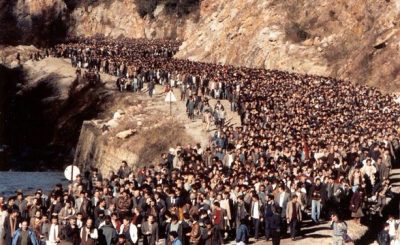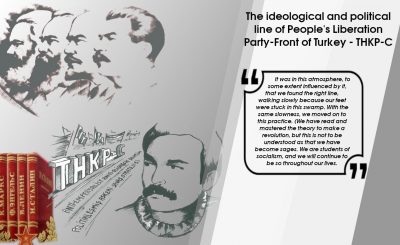For nearly three decades, the people’s war in the Philippines has overcome and outlasted a series of reactionary regimes, including a 14-year undisguised fascist dictatorship, and so many forms of intervention by the No. 1 imperialist power. It has proven all wrong the ill-wishes and slander of revisionist regimes and parties and their lackeys. It has prevailed over various erroneous currents of “Left” and Right opportunism. The revolutionary unity, fighting will and capabilities of the revolutionary forces and the people are higher than ever as a consequence of the rectification movement.
The people’s war in the Philippines has been able to achieve all of these because it resolutely upholds the leadership of the working class, puts into practice the Marxist-Leninist theory of state and revolution, perseveres in armed resistance to imperialism and reaction and holds high the hope of the working class in fulfilling its historic mission of defeating capitalism and building socialism.
Philippine Society and Revolution
To understand the course of the people’s war in the Philippines, it is necessary to grasp the basic character of Philippine society and the corresponding character of the Philippine revolution.
Philippine society is semicolonial. Though nominally granted its independence in 1946, the Philippines continues to be under the domination of US imperialism which indirectly rules the country through its local lackeys, the comprador big bourgeoisie and landlord class. These local exploiting classes, through their dominant political parties and interchanging ruling cliques, wield the appartuses of state power as agents of foreign monopoly capitalism.
Philippine society is semifeudal. It is agrarian and without basic and heavy industries. Even hand tools are imported to the extent of 85 percent. Only light manufacturing, heavily dependent on imported equipment, semi-manufactures and raw materials has been allowed. In the countryside, vast tracts of land owned by the landlords are tilled by peasants who rely mainly on sheer brawn and traditional peasant tools.
To address the semicolonial and semifeudal character of Philippine society, the Philippine revolution is national and democratic in character, in other words, antiimperialist and antifeudal. It aims to complete the interrupted struggle for national emancipation which started in 1896 but was frustrated by US imperialist intervention in 1898, and give substance to the democratic aspirations of the peasant majority for land through land reform.
Though our people’s war is a continuation of the old democratic revolution of 1896, it is of a new type. It is led by the proletariat and not by the bourgeoisie and operates in the context of the world proletarian socialist revolution and not in the context of the world bourgeois democratic revolution. It constitutes a preparation for carrying out a socialist revolution in our country.
Waging the people’s war is absolutely necessary in carrying out the new-democratic revolution. Armed struggle is the principal form of revolutionary struggle. It carries out the central task of the revolution, which is the seizure of political power. The strategic line of encircling the cities from the countryside and accumulating strength through tactical offensives until it becomes possible to seize power on a nationwide scale allows the Party and the people’s army to build Red political power in the countryside even while the counterrevolutionary state is still entrenched in the cities.
People’s war is a revolutionary mass undertaking. This mass undertaking is led by the proletariat through its advanced detachment, the Communist Party of the Philippines. It relies mainly on the peasantry, wins over the urban petty bourgeoisie and middle bourgeoisie, and takes advantage of the splits among the reactionaries in order to isolate and destroy the power of the worst reactionary puppet clique at every given time.
The New People’s Army
In carrying out a people’s war, the Party builds the people’s army as its main form of organization. The New People’s Army is under the absolute leadership of the Communist Party of the Philippines and it is where Party membership is most concentrated. It is a military, political, productive and cultural force. Aside from its military operations against enemy forces, it carries out land reform and mass base building.
As soon as it was established on March 29, 1969, the New People’s Army could do mass work and launch tactical offensives in the small radius of a district in one province. Almost thirty years after, it has created around 60 guerrilla fronts spread over 67 out of the total 77 provinces of the country.
The typical total force of a guerrilla front amounts to a company but it is divided into one platoon as the center of gravity and the other platoons are dispersed to cover a wider radius for mass work, subdividing into squads and further subdividing into armed propaganda teams, depending upon the concrete circumstances.
Since the start of the Rectification Movement in 1992, the politico-military training of Red commanders and fighters has stressed political education. This provides the revolutionary reasons for military training, operations and improving technique. Their ever rising level of revolutionary consciousness enables the Red commanders and fighters to perform effectively their fighting and other tasks in the service of the people.
Every unit of the New People’s Army develops close links with the masses. The NPA has consolidated and expanded the mass base in the guerrilla fronts. We have a mass base running in millions in more than 60 provinces. However, we need to increase the proportion of those enlisted in peasant and other types of mass organizations.
Consolidation work provides the stable basis for expansion work. Because of its consolidated and expanded mass base, the NPA has been able to launch tactical offensives within its capabilities in different parts of the country. Last year, we were able to capture a significant number of weapons from the enemy through raids and ambushes. Our initiative in battle was so high that we wiped out enemy units or captured enemy officials and men.
The tactical offensives in the second half of last year embarrassed the enemy nationally and internationally because they occurred soon after the highest military officials of the enemy boasted that the NPA had disintegrated and had been driven to remote areas and because two of these tactical offensives were carried out in town centers close to the national capital region and close to the headquarters of the Second Infantry Division.
The enemy’s embarrassment was aggravated when he was compelled to negotiate the release of the prisoners of war after the failure of their pursuit operations. High-ranking police officers who had been taken prisoner in Rizal and Mindoro were released by the NPA to the International Committee of the Red Cross (ICRC) under the NPA policy of lenient treatment and upon humanitarian considerations under the Geneva Conventions and its protocols. Reciprocally, the enemy released a number of political prisoners.
Brilliant tactical offensives have been undertaken in response to the call of the Party for intensifying tactical offensives within our capabilities. As is the nature and law of things, there is uneven development. Some regions or guerrilla fronts have better conditions and higher capabilities than others. There are cases where the mass base is sufficiently wide and deep but the determination, experience and skills to plan and carry out tactical offensives are deficient.
Prospects of the Revolution
Short of launching a fullscale war of aggression against the Filipino people, US imperialism has engaged in all forms of intervention in a futile attempt to destroy the armed revolutionary movement of the Filipino people.
These interventions have included instigating the Marcos fascist dictatorship and the post-Marcos sham democracy and massive doses of military assistance, loans and psychological warfare. The revolutionary forces have withstood all these and have been exemplary in persevering in people’s war for so long and in addressing thereby the central question of revolution.
Now, the world capitalist system is in an unprecedentedly grave crisis. The global centers of capitalism themselves are being shaken by the overaccumulation of finance and productive capital on the one hand and the rising levels of unemployment and deterioration of wage conditions among the proletariat on the other.
The Philippines is stricken with a far worsened social and economic crisis. This is the result of de-nationalization, privatization, deregulation, liberalization and labor flexibility — policies dictated by the imperialists and fawningly followed by their local running dogs. Advantageously, there are already the revolutionary forces, long tempered in the course of people’s war and revitalized by the rectification movement to further arouse, organize and mobilize the people against the imperialists and their reactionary stooges.
The urban-based legal democratic movement of workers and other urban poor, the women, youth, low-income professionals and the middle social strata is rising and bound the entire ruling system with massive protest actions against unemployment, rising prices and poverty.
The rural-based armed revolutionary movement is bound to grow and gain strength. Given that we are still in the strategic defensive of our revolutionary struggle, with the excellent objective conditions and the perseverance of the subjective forces, there is no way to go but forward.



